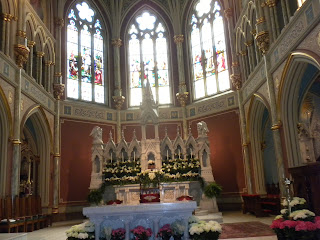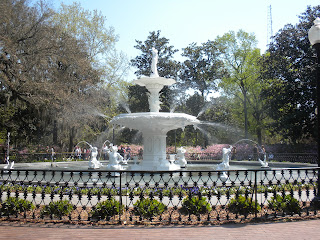Onto Georgia: Unfortunately, the cold temperatures and windy conditions forced us to abandon our plans to visit Cumberland Island which was high on our list of places to visit. Cumberland Island is only accessible by boat. It is a State Park and a well preserved wildness as well as home to wild horses. Oh well, we will have to come back one of these days.

The Captain demonstrating the 7-8 foot tides that boaters have to be wary of in the low country.
We had an easy crossing from Fernandina into Georgia and arrived at Jekyll Island early enough to borrow courtesy bicycles from the marina and tour the Island.
Oak trees with Spanish Moss abound.
Jekyll Island was a winter retreat for the rich and famous in the 19th and 20th Century. Many of their "cottages" have been donated and restored.
The centerpiece of the Historic District is the enormous Jekyll Island Club Hotel, a two-winged structure. Thirty-three buildings from the late nineteenth and early twentieth centuries surround the hotel, with many being mansion-sized cottages.
Anyone for croquet? We are still trying to figure out the rules.
The Island also hosts a turtle hospital where rescued and grounded turtles are healed before being returned to the wild.
Reconstructed prehistoric giant turtle skull. The turtle was estimated to weigh 11,000 pounds!
Moon setting as we prepared to leave Jekyll Island. Sections of the ICW that we have to traverse today are so shallow that we need to time our journey so that we cross them at mid to high tide. One such section is the infamous Little Mud River. Fortunately, we timed it right and did not hit the bottom once!
Typical low marsh land that borders the ICW in Georgia.
Not much traffic today on the ICW. We saw only a few shrimp boats.
And a few more modest cottages.
March 29: The Landings on Skidaway Island, Savannah Georgia:
We anchored last night in Kelkenny Creek so that we could time our arrival through Hell Gate and onto Delegal Creek Marina on Skidaway to take advantage of the current and tide.
Another beautiful sunrise saw us up early and ready to leave. In case no one has noticed, many boaters like us go to bed with the sun and rise with it. The Landings will be our home for the next week or so as we continue our retirement location search and explore Savannah.
Some brief history notes on Savannah from the Historical Society: In 1733, General James Oglethorpe, and 114 men women and
children aboard the two hundred-ton galley ship “Anne” landed on a high bluff
along the Savannah River called Yamacraw Bluff
by the local Creek Indians.
Oglethorpe named the thirteenth colony Georgia after King George II, and Savannah North Carolina
Oglethorpe and his engineers
designed “America
Forty-two Jewish refugees arrived
on July 11, 1733, having fled persecution in Portugal Georgia
to start a new life including Moravians and Salzburgers from Germany
In 1864 when General William Tecumseh Sherman marched in,
the mayor of Savannah gave Sherman Savannah Savannah
Memorial to the Irish Settlers
American towns don't come much more beautiful than Savannah. The historic district is arranged around garden squares which form the core of the original city. We walked through 14 different squares. The squares are dominated by old Live Oak trees that are draped with Spanish Moss. We saw one tree that is over 270 years old.
The Historic District boasts examples of just about every architectural style of the eighteenth and nineteenth centuries. Maureen was quite taken with the houses and is responsible for the large number of photos in the blog.
St. John's Cathedral
More historic houses
and a few more....
The fountain in Mercer Park made famous in the book "In the Garden of Good & Evil".
A Scottish Wedding was taking place on one side of the fountain in Mercer Park. The bride looked lovely in her tartan. The bridal party was accompanied by the Scottish bagpipes.
More examples of Savannah architecture...
Our walking tour hosts-Mike & Vali
Yet another beautiful square.
City Hall viewed from Johnson Square-the oldest square and the template that Oglethorpe used for all the other squares.
Memorial to Theodore Francis Green. He was an important General in Washington's army. Originally from Rhode Island, he died and was buried in Savannah.
Fort Pulaski
View of the inner courtyard
Confederate Soldier
View across the marshes and the moat surrounding the Fort.
Needless to say, we throughly enjoyed our stay in the Savannah area. We found the people to be very friendly and laid back and thought this local saying summed things up well: Southerners joke that in Atlanta, the first thing locals ask you is your business; in Charleston, they ask your mother's maiden name; and in Savannah
We also paid a visit to Tybee Island which is another barrier island. En route, we stopped at Fort Pulaski which was built in the mid 19th Century to defend the river approaches to Savannah. The Fort was named for the Polish Count Casimir Pulaski. Count Pulaski fought for the American side during the Revolutionary War. He lost his life in the battle for Savannah where he is buried.
Fort Pulaski was one of many Federally built forts along the Eastern seaboard designed to protect the coast from foreign invasion. It was considered to be invincible. However, after the Southern States seceded from the Union it was rendered obsolete by new rifled cannons that the North had developed. This new technology allowed the Union army to bombard the Fort from a mile away which was twice the effective range for cannons of the day. The walls of the Fort were breached and the Confederate Commander, Col. Charles Olmstead surrendered 30 hours after the bombardment began. The rapid fall of Fort Pulaski marked the demise of this type of fortified structures along the Eastern United States.
Fort Pulaski
View of the inner courtyard
Confederate Soldier
View across the marshes and the moat surrounding the Fort.




















































No comments:
Post a Comment